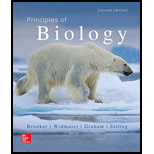
Principles of Biology
2nd Edition
ISBN: 9781259875120
Author: Robert Brooker, Eric P. Widmaier Dr., Linda Graham Dr. Ph.D., Peter Stiling Dr. Ph.D.
Publisher: McGraw-Hill Education
expand_more
expand_more
format_list_bulleted
Question
Chapter 18.3, Problem 1TYK
Summary Introduction
Introduction:
The genome is the complete set of genetic materials present in a cell or an organism. Genome of many bacterial and archaeal species have been sequenced up to date. The length of bacterial and archaeal chromosomes is about few millions base pairs long and are usually circular. But linear chromosomes are also found in some species. bacterial and archaeal genomes are less complex compared to eukaryotic genome.
Expert Solution & Answer
Want to see the full answer?
Check out a sample textbook solution
Students have asked these similar questions
please fill in missing parts , thank you
please draw in the answers, thank you
a. On this first grid, assume that the DNA and RNA templates are read left to right.
DNA
DNA
mRNA codon
tRNA anticodon
polypeptide
_strand
strand
C
с A
T
G
A
U
G
C A
TRP
b. Now do this AGAIN assuming that the DNA and RNA templates are read right to left.
DNA
DNA
strand
strand
C
mRNA codon
tRNA anticodon
polypeptide
0
A
T
G
A
U
G с
A
TRP
Chapter 18 Solutions
Principles of Biology
Ch. 18.1 - In the procedure shown in this figure, has the...Ch. 18.1 - Refer back to Figure 9.16. Why are primers needed...Ch. 18.1 - Prob. 2CCCh. 18.1 - Prob. 3CCCh. 18.1 - Prob. 4CCCh. 18.1 - Prob. 2BCCh. 18.1 - Prob. 1TYKCh. 18.1 - Prob. 2TYKCh. 18.1 - Prob. 3TYKCh. 18.2 - Prob. 1CC
Ch. 18.2 - Prob. 2CCCh. 18.2 - Prob. 1TYKCh. 18.2 - Prob. 2TYKCh. 18.2 - Prob. 3CCCh. 18.3 - Prob. 1TYKCh. 18.4 - Prob. 1CCCh. 18.4 - Prob. 1BCCh. 18.4 - The sizes of eukaryotic genomes vary because more...Ch. 18.4 - The members of a gene family are called paralogs....Ch. 18.5 - Prob. 1CCCh. 18.5 - Based on their mechanism of movement, which type...Ch. 18.5 - Prob. 1TYKCh. 18.5 - A segment of DNA that moves via an RNA...Ch. 18 - Prob. 1TYCh. 18 - Prob. 2TYCh. 18 - Lets suppose you followed the protocols described...Ch. 18 - Prob. 4TYCh. 18 - Lets suppose you want to clone a gene that has...Ch. 18 - In the CRISPR-Cas technology used for mutating...Ch. 18 - Prob. 7TYCh. 18 - Prob. 8TYCh. 18 - Prob. 9TYCh. 18 - Prob. 10TYCh. 18 - Draw the structure of a dideoxyribonucleotide...Ch. 18 - Prob. 2CCQCh. 18 - Prob. 3CCQCh. 18 - Identify and discuss three important advances that...Ch. 18 - Prob. 2CBQ
Knowledge Booster
Learn more about
Need a deep-dive on the concept behind this application? Look no further. Learn more about this topic, biology and related others by exploring similar questions and additional content below.Similar questions
- Please identify the curve shown below. What does this curve represent? Please identify A, B, C, D, and E (the orange oval). What is occurring in these regions?arrow_forwardPlease identify the test shown here. 1) What is the test? 2) What does the test indicate? How is it performed? What is CX? 3) Why might the test be performed in a clinical setting? GEN CZ CX CPZ PTZ CACarrow_forwardDetermine how much ATP would a cell produce when using fermentation of a 50 mM glucose solution?arrow_forward
- Determine how much ATP would a cell produce when using aerobic respiration of a 7 mM glucose solution?arrow_forwardDetermine how much ATP would a cell produce when using aerobic respiration to degrade one small protein molecule into 12 molecules of malic acid, how many ATP would that cell make? Malic acid is an intermediate in the Krebs cycle. Assume there is no other carbon source and no acetyl-CoA.arrow_forwardIdentify each of the major endocrine glandsarrow_forward
- Come up with a few questions and answers for umbrella species, keystone species, redunant species, and aquatic keystone speciesarrow_forward19. On the diagram below a. Label the three pictures as: DNA; polypeptide; or RNA. b. Label the arrows as: translation or transcription/RNA processing. c. Add the following details to the diagram. Promoter region TATA box Transcription start site Transcription terminator Intron (A,B,C,D) Exons (1,2,3,4,5) Splice sites 5' cap 5' UTR (untranslated region) 3' poly A tail 3' UTR (untranslated region) Translational start (AUG) Translational stop (UGA, UAG, or UAA) N and C ends of polypeptide 0000arrow_forwardMatch the letter labels in the figure below to the terms. Some letter labels are not used. MNNNNNNIN M C B A M D F E H K G 8arrow_forward
arrow_back_ios
SEE MORE QUESTIONS
arrow_forward_ios
Recommended textbooks for you

 Biology Today and Tomorrow without Physiology (Mi...BiologyISBN:9781305117396Author:Cecie Starr, Christine Evers, Lisa StarrPublisher:Cengage Learning
Biology Today and Tomorrow without Physiology (Mi...BiologyISBN:9781305117396Author:Cecie Starr, Christine Evers, Lisa StarrPublisher:Cengage Learning Biology 2eBiologyISBN:9781947172517Author:Matthew Douglas, Jung Choi, Mary Ann ClarkPublisher:OpenStax
Biology 2eBiologyISBN:9781947172517Author:Matthew Douglas, Jung Choi, Mary Ann ClarkPublisher:OpenStax Comprehensive Medical Assisting: Administrative a...NursingISBN:9781305964792Author:Wilburta Q. Lindh, Carol D. Tamparo, Barbara M. Dahl, Julie Morris, Cindy CorreaPublisher:Cengage Learning
Comprehensive Medical Assisting: Administrative a...NursingISBN:9781305964792Author:Wilburta Q. Lindh, Carol D. Tamparo, Barbara M. Dahl, Julie Morris, Cindy CorreaPublisher:Cengage Learning




Biology Today and Tomorrow without Physiology (Mi...
Biology
ISBN:9781305117396
Author:Cecie Starr, Christine Evers, Lisa Starr
Publisher:Cengage Learning

Biology 2e
Biology
ISBN:9781947172517
Author:Matthew Douglas, Jung Choi, Mary Ann Clark
Publisher:OpenStax

Comprehensive Medical Assisting: Administrative a...
Nursing
ISBN:9781305964792
Author:Wilburta Q. Lindh, Carol D. Tamparo, Barbara M. Dahl, Julie Morris, Cindy Correa
Publisher:Cengage Learning
Prokaryotic vs. Eukaryotic Cells (Updated); Author: Amoeba Sisters;https://www.youtube.com/watch?v=Pxujitlv8wc;License: Standard youtube license